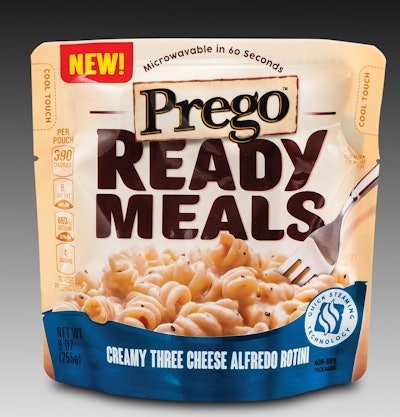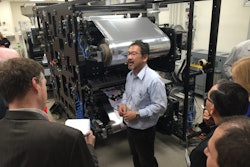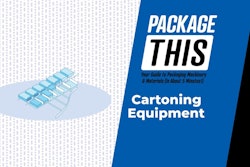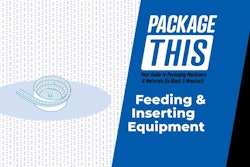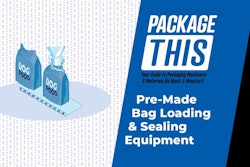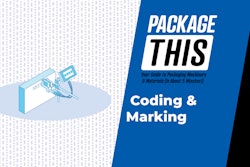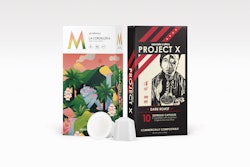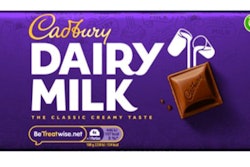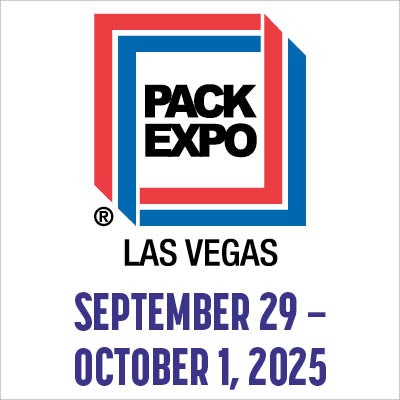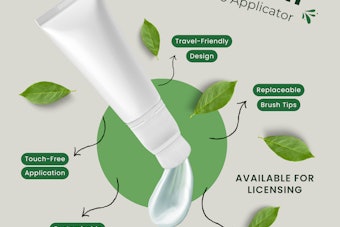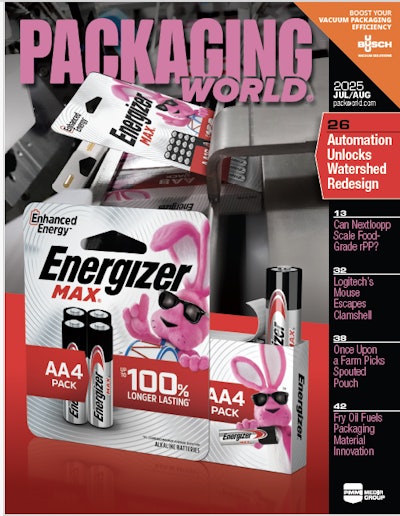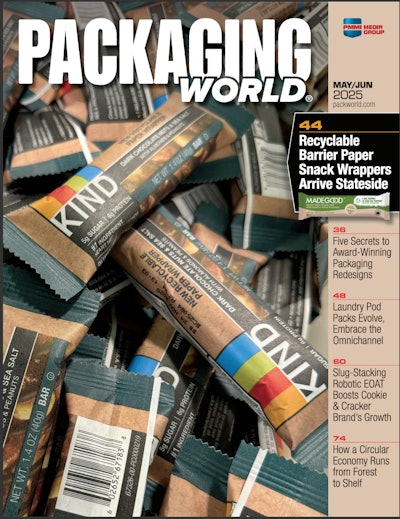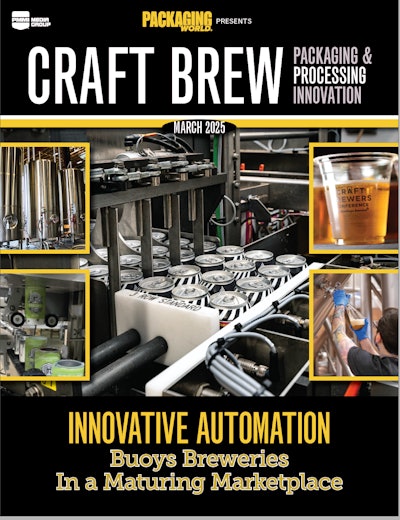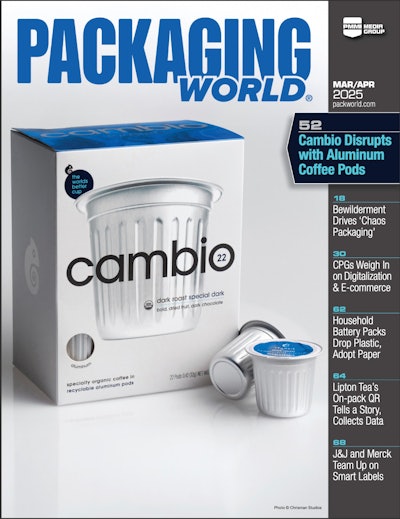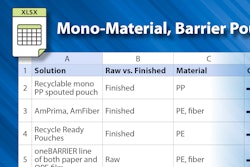Self-venting retort pouch
Described as “the first self-venting retort pouch for portable meals that looks and functions like a bowl,” the package for 9-oz portions of Campbell Soup Co.’s Prego and Pace brands of ready meals is the winner of the Highest Achievement Award in the 2016 Flexible Packaging Achievement Awards.
This BPA-free microwaveable standup pouch makes it possible to enjoy hot meals virtually anywhere in 60 seconds. The easy-open tear creates an instant bowl, so consumers can eat right out of the pouch. With no refrigeration needed, a portable size, a unique heat/eat bowl format, and quick cook times, it’s no wonder Campbell brand managers have adopted this marketing tag line: “You won’t believe convenience tastes this good.” The Prego pouches were available at a Target store in Chicago for $2.29 each.
The supplier behind the premade pouch, Bemis Flexible Packaging, says it’s FDA-compliant at temperatures to 275 deg F. The high-performance clear barrier lamination incorporates PET, nylon, and polypropylene sealant. The reverse-printed 48-ga OPET gets a retort-grade clear barrier coating, though Bemis chooses not to identify it. This robust, stiff, resilient structure allows the pouch to stand reliably and function as a bowl while delivering a 12-month shelf life. The clear Doy-style bottom gusset lets consumers see the meal quality and variety before purchasing. Specially engineered sealants and inks—the package is gravure printed in eight colors—resist the heat and abuse of the retort process to deliver an ultrastrong flexible pouch with vibrant brand graphics. Plus the package is self-venting, so consumers do not need to open the pouch before microwaving.
In addition to the controlled venting, the pouch includes cool touch zones that are clearly identified on both the front and back. This is where one’s fingers can safely and comfortably grab the pouch when it’s time to remove it from the microwave oven and tear it open.
Also called out on the lower right front is the Quick Steaming Technology that allows the pouch to act as a miniature pressure cooker, quickly and evenly heating the contents. Carefully positioned vents in the film release steam, thus eliminating hot or cold spots for perfectly prepared meals. The quick, even heating maintains the optimal texture, flavor, and quality of the food and avoids overheating.
Campbell and Bemis describe the pouch as a convenient alternative to shelf-stable meals in metal cans, glass jars, or trays with flexible film lidding. Designed originally for lunches, the format works for any meal or time of day.
Creating a bigger, flatter billboard on shelf than cans or jars, the pouch’s bold graphics, bowl-like design, and large face panels dramatically differentiate the convenient new concept. Crisply printed infographics and icons call attention to the pouch’s special features, from cool touch handling areas to the Quick Steaming technology. The pouch is also described as significantly more space-saving than cans, allowing more packages to fit on the shelf at any given time so that time spent restocking is kept to a minimum.
In addressing the sustainability features and environmental benefits associated with this package, Bemis says the pouch has a number of advantages over traditional metal cans. For one thing, it eliminates Bisphenol A, the epoxy-based coating applied inside tin-plated cans to protect food from metal corrosion and bacteria. Bemis also cites FPA data showing that flexible pouches consume 75% less energy than metal cans, generate one-tenth the CO2 emissions that production of metal cans does, weigh less than 1/10 what a can weighs, and occupy so much less space than cans that one truckload of retort pouches will hold the same amount of product as 15 truckloads of cans. Bemis also notes that recent Walmart Scorecard Modeling for similar flexible pouches shows an 85% reduction in the product-to-package ratio of flexible pouches over cans. Finally, says Bemis, compared to ready meals in a tray-plus-flexible film lid format, the one-piece pouch has a lower environmental impact and source reduction advantages over manufacturing, warehousing, and transportation of separate trays, lidstock, and sleeves.
Bemis emphasizes that while this retort pouch looks simple, the technology behind it is anything but. Significant research has gone into developing, testing, and validating structural design and vent placement, not to mention cooking performance, food interaction, flexible retort materials, and consumer convenience.
Bag design addresses slippage problems
From wrapping stretch/shrink bundles to stacking and securing pallet units to displaying products on store shelves, film wrapped products can present logistical challenges for warehouses, shippers, and retailers. Specifically, such bags are slippery and have a tendency to shift out of desired position. The Kohinoor Anti-Slip rice bag, developed for Kohinoor Foods/Indo European Foods Ltd. by Flex Film (USA), Inc., offers a bag slippage solution that has earned FPA Gold Award honors both for Packaging Excellence and for Printing and Shelf Impact achievement.
Kohinoor’s rice bags are made from a 3-ply flexible film (BOPP film/metallized BOPET film/LDPE film). Reverse-printed 8-color matte is done via rotogravure. After the film structure is laminated and printed, it is micro-embossed in register with the print design. The material then is converted into stand-up bags, ranging in sizes from 1 to 20 kg. Bulk sizes incorporate a carrying handle. The bags are filled with rice at Kohinoor’s facilities and closed using a transverse seal in a conventional fill/seal operation.
The unique characteristic of these stand-up rice bags is the anti-slip feature, achieved by the special micro-embossing process on the finished lamination prior to bag making. This process prevents the face-to-face stacked barrier-film, puncture-resistant bags (designed to be impervious to mites and micro-organisms) from sliding over each other and off the stack. The micro-embossing delivers a very high coefficient of friction that deters bag slippage, even when bags are stacked several feet high. In addition, the embossing is registered, only appearing on the central portion of the bag, and not readily visible. So it does not affect bag graphics in any way.
When introduced into various global markets, these anti-slip rice bags were quickly successful. By some estimates, Kohinoor recorded sales increases of 300% in the first six months.
Personalized potato chip packs
Packaged goods manufacturers are mad about consumer engagement these days, and a lot of them see packaging as the ideal vehicle by which to achieve their engagement goals. One such initiative last year was the Lay’s Summer Days campaign from PepsiCo’s Frito-Lay division, where consumers were encouraged to create custom, personalized bags of Lay’s potato chips featuring photos of their favorite summer moments. FPA judges were so impressed with the campaign they gave it a Gold Award for Printing and Shelf Impact.
Crucial to the success of the program was the digital printing prowess of Emerald Packaging. Here’s how it worked. From May 12 through July 4 consumers could visit www.lays.com to connect with the Lay’s Summer Bag Creator. This interactive tool allowed them to upload a summer photo, caption it, and receive a digital version of a Lay’s potato chips bag featuring their photo on it. Once the digital version was available in their laptop or mobile device, they were able to send their virtual bag of chips off to friends and family via social media.
So where did real live flexible packaging come in? The first 10,000 approved submissions were sent to Emerald Packaging. There the images were sorted, manipulated, and then reverse-printed in sequence on an HP Indigo 20000 digital press. The printed substrate, unnamed by Emerald, was then adhesive laminated to a second unnamed substrate and the two-layer lamination was sent to a Frito-Lay fulfillment facility. There the flexible film was fed through a vertical form/fill/seal system, out of which the personalized 8-oz bags of chips emerged.
The file manipulation was particularly complex, notes Emerald Packaging, as the photos came in a variety of formats, resolutions, and image quality. Also notable is that a unique code was printed onto each impression linking the photo to the name and mailing address of the person who submitted it. This allowed the fulfillment facility to scan the code and generate a shipping label to get the individual package to the consumer.
Supporting this project were OEC Graphics on prepress and data base management as well as HP Indigo on digital press and print support. According to Emerald Packaging, this package represents a first of its kind in the wide web flexible packaging sector. “The variable data aspect of the package had never been done in this manner,” says the firm.
“Summer is all about creating memories that last a lifetime, and we are always excited to play a role in those experiences,” says Tina Mahal, Senior Director of Marketing at Frito-Lay North America. “The ‘Lay’s Summer Days’ promotion is a way for us to celebrate our fans and the season by personalizing their connection with the brand in fun, unique way.”
Medical pouch earns Gold Award in Technical Innovation
Steam, pressure, time and temperature represent the four parameters of steam sterilization, which is executed within an autoclave (steam) sterilizer to destroy microorganisms to prevent potential disease transmission.
Many medical device manufacturers sterilize in one package and then seal the sterile package in a second barrier pouch to provide moisture protection. But the new Autoclavable Dispos-a-vent® Barrier Pouch from Oliver-Tolas Healthcare Packaging enables sterilizing in one porous package.
The pouch withstands the high temperatures of autoclave sterilization, and provides barrier to moisture for devices requiring moisture to remain in the primary package after sterilization and until point of use. The Autoclavable Dispos-a-vent Barrier Pouch is designed with a disposable Tyvek® vent for maximum airflow during autoclavable sterilization.
By eliminating the materials that a second pack would require, the barrier pouch improves efficiencies, reduces costs, and enhances sustainability.
The pouch’s innovation and functionality helped it earn FPA honors with a Gold Achievement Award in Technical Innovation.
Although the package is in use commercially, the Oliver-Tolas customer asked to remain anonymous.
The pouch employs a high-barrier foil lamination that provides maximum moisture and oxygen barrier properties to extend the shelf life of the device. The puncture-resistant, high-density polyethylene coextruded sealant layer prevents tray edges or sharp ends of medical devices from puncturing the pouch.
Cookie pouch scores impressive sustainability stats
Sustainability is front-and-center as a key objective for many consumer goods packagers. It was with that objective in mind that the Fresh N Tasty® Bakery 12-count cookie pouch was developed in conjunction with Robbie Flexibles for Fresh N Tasty’s in-store bakery department. The highly successful packaging approach has earned a Flexible Packaging Association Gold Award for Sustainability Achievement.
Robbie makes the pouch from a multilayer adhesive lamination that it purchases from an outside supplier. Specific details on the structure are considered proprietary, but Robbie does indicate that among the layers in the lamination is a coextrusion that brings stay-fresh barrier properties. Three-color surface printing brings graphic pop, and a clear window lets package contents show through. A slim package profile means space-efficient transport and storage, plus the package’s carry handle and reclosable zipper offer consumer convenience.
Robbie’s stock line, small-footprint pouches are available in a range of sizes to accommodate the needs of various in-store bakery products and offer an environmentally favorable alternative to clamshells.
Life Cycle Assessment (LCA) comparative analyses of these pouches versus more traditional clamshells indicate that the pouches are easily three times less in packaging material weight, emit approximately 79% less CO2 during production, and require approximately 75% less fossil fuels to produce.
Comparisons of transportation/distribution costs and the consequential CO2 emissions during transport/distribution also are impressive. Reportedly, it takes 56 more pallets and 3.3 times more trucks to ship clamshells versus an equivalent amount of Robbie pouches. CO2 emissions generated by conventional clamshell shipments is estimated to be four to five times higher than equivalent Robbie pouch shipments. In addition, warehouse space required to accommodate the pouches is reduced by about 55% versus clamshell warehousing. And the emptied pouches require about 69% less landfill space than the corresponding amount of clamshells.
Squeezable pouch for Daisy makes it easier to ‘do a dollop’
Five years in the making, a new inverted, wedge-shaped flexible pouch with a flip-top dispensing cap for Daisy Sour Cream ticks off all the boxes on Daisy Brand’s original wish list for an innovative new dairy package with both functional and aesthetic benefits. The squeezable 14-oz pouch also ticked off the right boxes for FPA judges, who awarded the package with a Gold Achievement Award for Technical Innovation.
As Daisy Brand Director of Marketing Craig Ziemkiewicz explains, Daisy became more aware of the opportunity to enhance consumers’ experience with its sour cream product through packaging innovation in 2010, but took a very deliberate approach to development in order to fully understand and address consumer needs.
“From a functional perspective, consumers use sour cream in two ways: as a topping and as an ingredient,” he explains. “The traditional cup supports ingredient use well, but is less ideal for topping usage. As a result, precise application of sour cream for topping occasions was the primary goal. However, the package also had to be usable for ingredient purposes. Other requirements included being able to get all of the product out (minimizing waste), family-friendly ergonomics (for younger children), a patentable design that reduced contamination, national sales demand, and a visually appealing package to convey strong branding on shelf.”
Continuum Innovation kicked off the project by conducting market research around available packaging formats, consumer needs, and product requirements, and then designed the pouch concept based on their findings. Continuum also helped Daisy identify those packaging suppliers that could overcome the technical hurdles involved with making the design prototype a production reality.
To develop the laminate/film structure and convert the pouch, Daisy selected Sonoco Flexibles. According to the entry form submitted by Sonoco to FPA, specification of the film structure was one of the key components for the Daisy Squeeze pouch. Says the entry form, “Daisy needed light barrier in the film to protect the product quality and prolong shelf life. At the same time, Daisy also needed the pouch to be a bright white color to match the color of their white plastic cups, which would be retailed alongside Daisy Squeeze.”
To achieve both the required barrier and the bright white appearance, Sonoco developed special materials and ink systems that are also robust enough to survive drops and rough handling, and protect the product through distribution, retail, and consumer use.
While details on the construction of the pouch are proprietary, Daisy describes it as “the first inverted flexible foil package used in dairy.” Pouch material is gravure-printed by Sonoco and supplied to Daisy as rollstock, which is formed, filled, and sealed on “first-of-its kind” equipment.
To achieve its wedge shape, the pouch features two triangular seams, with the opening of the pouch sealed or welded to the package’s other custom, proprietary feature: a two-piece, flip-top injection-molded polypropylene cap from Aptar Group that provides both dispensing functionality and tamper-evidence. The square, 50-mm closure incorporates a TE pull-ring that is removed before use and a silicone dispensing valve that dispenses product only when the pouch is squeezed. This allows for easy-to-control, drip-free dispensing, which is especially convenient for consumers using the sour cream as a topping. The reclosable dispensing cap also helps maintain product freshness between uses.
The squeeze pouch was introduced to all major grocery outlets in the U.S. in February 2015, alongside Daisy’s tub packages in the refrigerated dairy section. Daisy was able to leverage its existing national customers to aid in the rollout. According to Ziemkiewicz, the response from both consumers and retailers, who have been hungry for innovation in the dairy category—“especially in a category like sour cream that has lacked packaging innovation”—has been exceptional.
“However,” he adds, “the true measure of success ultimately comes down to sales. Judging by the sales data so far, Daisy has every reason to believe the new product will be successful in the long term.”
To view photos of the Silver winners, go to pwgo.to/2023.
